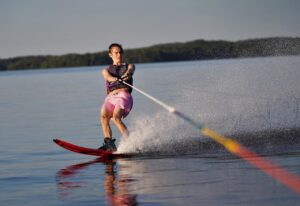Kneeboarding is the term for sliding down a slope while kneeling. It’s a fantastic option for those looking to get started with watersports. There are several purchasing guides for kneeboarding newcomers, but what about the size?
Whether you’re interested in a sport like surfing, kayaking, or even ice-skating, it’s critical to get the appropriate sized gear. It isn’t only for your safety; you’ll discover that the proper kneeboard will also help you enjoy the activity much more.
If you’re looking for a kneeboard size chart, you’ve come to the correct place. Today’s blog post is going to cover choosing the appropriate sized kneeboard from several manufacturers, as well as some sought-after kneeboarding advice. Continue reading to find out more!
General Sizing Guide
Let’s be honest. If you’re a seasoned kneeboarder, you only need to look at a kneeboard to determine if it fits you correctly. However, a newbie may not have that option and would be subjected to considerable trial and error before finding one that fits them well.
Some kneeboards are capable of fitting a wide range of individuals. A recreational kneeboard, for example, may be lightweight and feature adjustable thigh straps, allowing both novice children and seasoned adults to use it.
If you’re shopping for a competitive kneeboard, you’ll notice that it’s considerably thinner than a recreational one. They are also lighter and have more pointed edges.
It’s preferable to search for boards that are a bit shorter in length than you are tall. Extra length or thickness, or width isn’t helpful. A foam interior would assist a beginner keep afloat while also slowing down and obstructing their movements.
If you’re looking for a kneeboard, the first thing I’d suggest is checking out the size charts of the same brand. In the following section, we’ll look at a few prominent company’s size charts.
O’Brien Kneeboard Size Guide
Shaped and slalom O’Brien kneeboards are divided into two types. The shaped version has only one speed range, which is 26-30 MPH.
If you weigh less than 180 pounds, a kneeboard with a length of 65 inches to 66 inches would be ideal. If you weigh 210 lbs or more, the 67 inch to 68 inch board is recommended. It’s better to get the 68 inch to 69 inch board if you’re over 210 pounds.
Slalom kneeboards, on the other hand, provide a wider range of speeds. There are 26-30 mph, 30-34 mph, and 34-36 mph speed ranges. The length of the kneeboard you choose is determined by your weight rather than the speed.
The 59″ kneeboard is ideal for riders under 100 pounds. The length of the board rises proportionally to your weight, just like with regular kneeboards.
If you weigh between 115 and 140 pounds, the 61″-66″ board is ideal. If you weigh more than 200 pounds, choose one with a length of 68′′ to 69′′.
If you’re having difficulties converting kilograms to pounds, keep in mind that 1 pound is equal to 0.45 kgs. If you still have questions, a longer board than a shorter one is preferable.
Jobe kneeboard Size Guide
Kneeboards come in a large number of shapes and designs, which is good news for surfers that want to find one that fits their own preferences. Jobe has several versions and styles of kneeboards available. You might also choose a design from their collection.
Jobe generally provides kneeboards for beginners and experts, depending on the needs of customers. The Job Streak is a good example of a beginner kneeboard with softer, broader edges. They’re also made to be easy to use by young children.
Jobe’s competitive kneeboards would be an excellent choice if you’re searching for something more advanced. The Jobe Stage is one of them. These are considerably lighter than beginner-level kneeboards and have a lower profile. While a beginning skier may struggle to manage them, a professional would find them simpler to execute tricks with.
If you’re not sure what to pick, there are alternatives available, such as the Jobe Prophecy.
Kneeboarding Tips
- When kneeboarding, keep your body in good form. Many people think they’ll hurt their knees while kneeboarding, but actual pressure is placed on the back and neck. Aside from posture, you should also elongate adequately to keep your back and neck flexible and discomfort-free.
- The knee strap is a good idea for beginners, but don’t use it if you’re new. Most people believe that putting on the knee strap makes them feel safer. However, if you’re a novice or young, the knee strap will seem restrictive and will panic you in the event of a fall. For some time, practice without it.
- Keep your kneeboard and its accessories in good shape. Check to see whether the kneeboard has any projections that could inadvertently snag against your skin and give you an injury. Because anything might be broken at any time, double-check everything before going out into the sea.
- Always wear a floatation device to keep yourself secure if you fall into the water. Make sure the flotation is suitable for your body type, or it will slide about on your body and cause more harm than good.
- Remember, these sizing charts are only rough guidelines. You’d have to select your kneeboard carefully since it depends on more than just your weight. Determining which board is appropriate for you also takes into account your skill level.
Conclusion
I hope the information I provided in this blog post will assist you in your search for the perfect kneeboard. If you’re still unsure, I’ve got a few final recommendations for you. The easiest option is frequently the greatest solution, so don’t give up!
If you’re purchasing online, you may also go through the reviews to see whether it’ll work for someone your age, height, and body weight. If you buy from a store, the ideal approach to go is to receive a recommendation from the staff.
